The Nova hybrid buses are out and about
The Nova hybrid buses are out and about
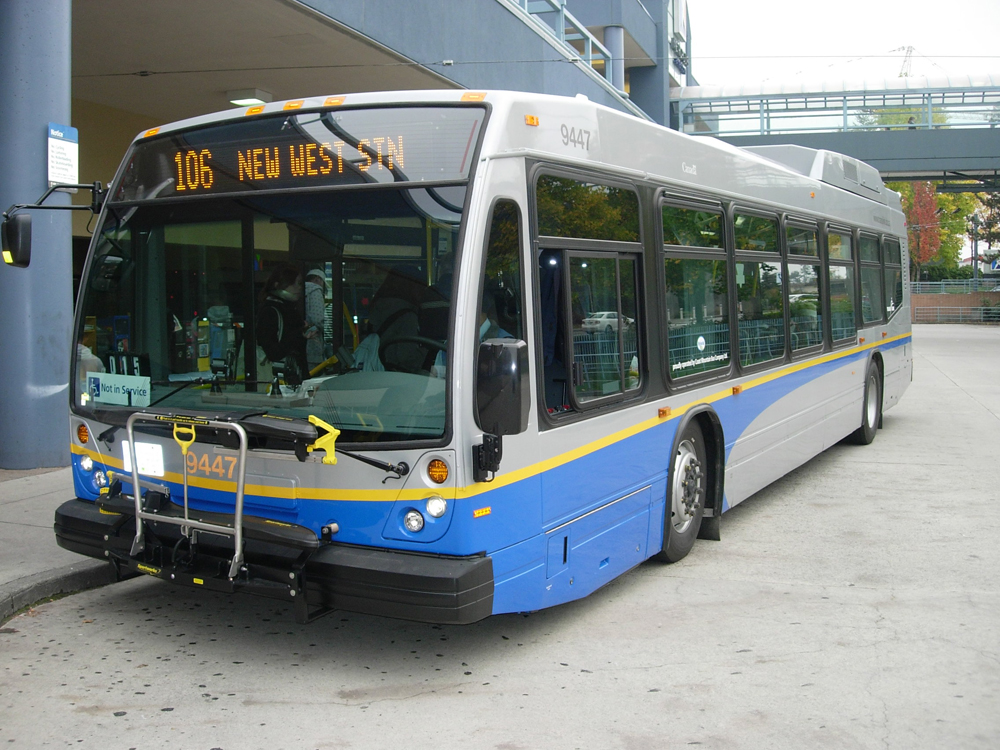
The first of our diesel-electric hybrid buses from Nova went into service this week!
Seventeen Nova hybrids arrived a few weeks ago, and after getting radios installed, the first few went into service on routes like the 130 and the 106.
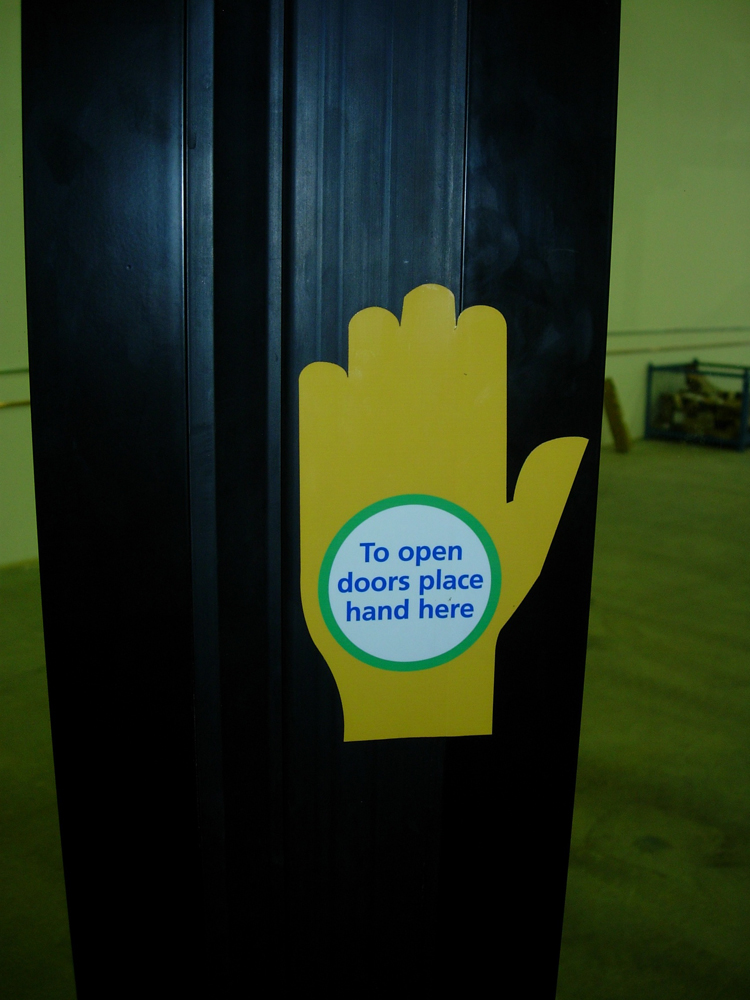
We’re expecting 141 of these vehicles in total over the next three months, and we do already have 39 articulated hybrid buses from New Flyer on the streets — they all went into service by September 2009.
So, how can you spot these hybrids? Again, from the outside, the biggest difference from a conventional bus is the big grey boxy hump on top of the back section. And there’s also a hybrid sticker on the window beside the front door.
Look out for the interiors too — the interior layout is the same a regular Nova, except now it has two rows of rear-facing seats in the back.
The seats also have new upholstery, like the seats on the articulated hybrids and the new SkyTrains. Plus there’s new door stickers, and the stanchions (the yellow poles) have a new arched design!
Here’s what I was told about how the hybrids work, by the way:
The hybrid buses use a smaller diesel engine and start off from a stop on an electric motor powered by a battery pack and diesel powered generator. The buses are quieter than any previous diesel bus in the TransLink fleet and the hybrids should have 20% better fuel economy and 20% lower green house gas emissions. The buses have to be operated in very urban bus service (lots of stop and go) to regenerate power to the batteries under braking.
Also, for those curious, I’m told the Nova hybrid vehicle numbers are from 9401-9542, skipping over 9500.
More photos of the buses, all courtesy of Leon from our engineering group!
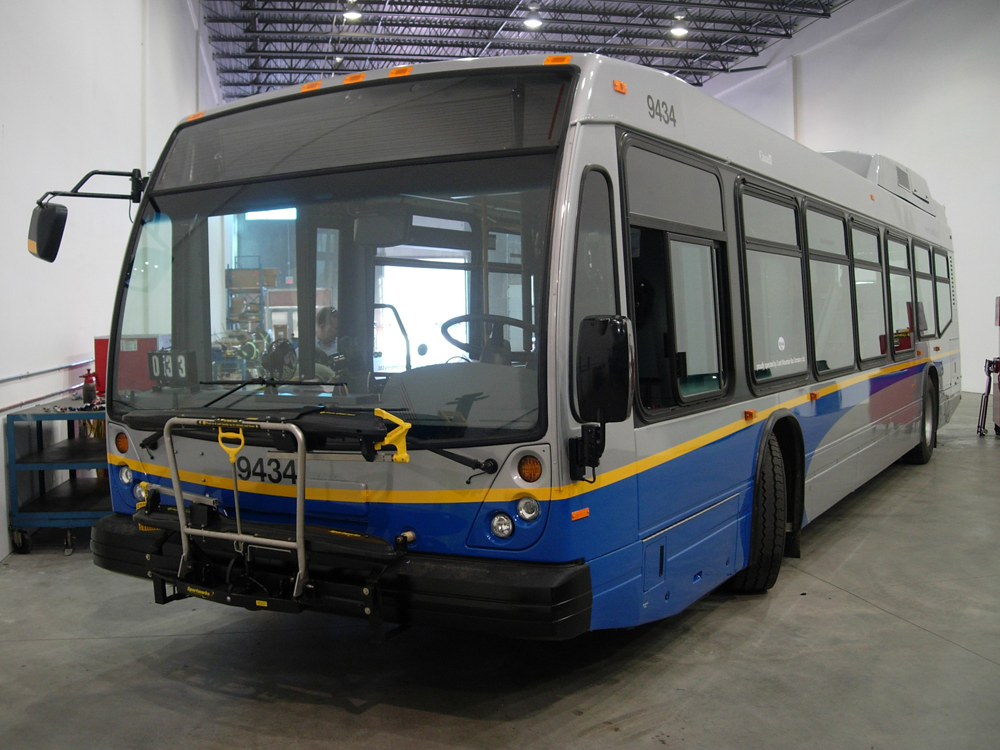
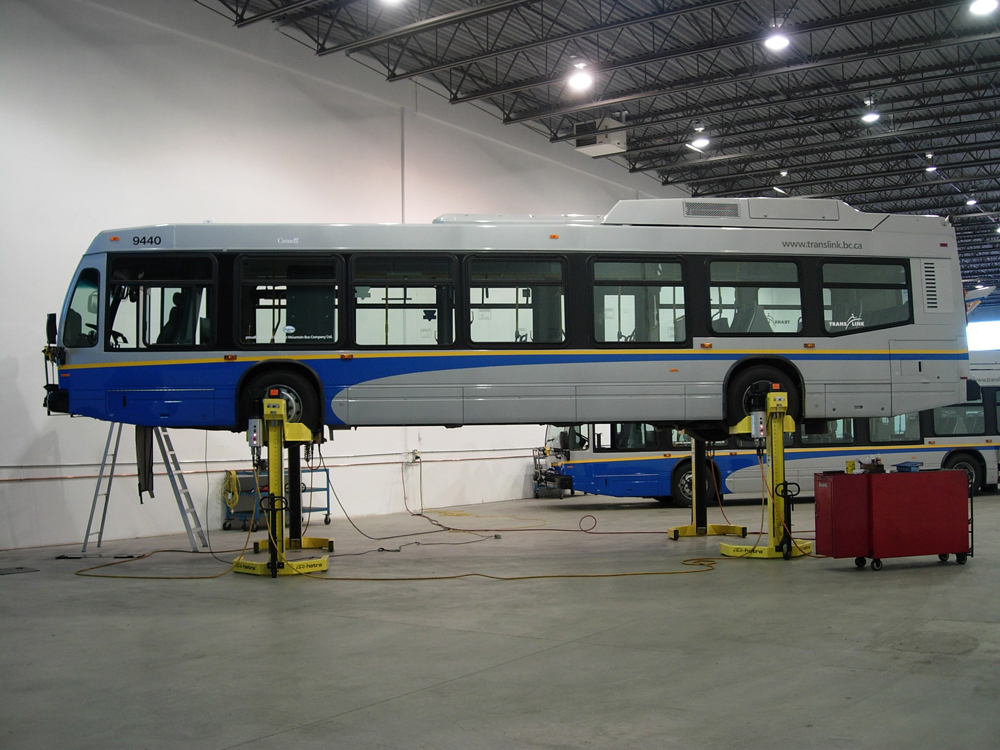
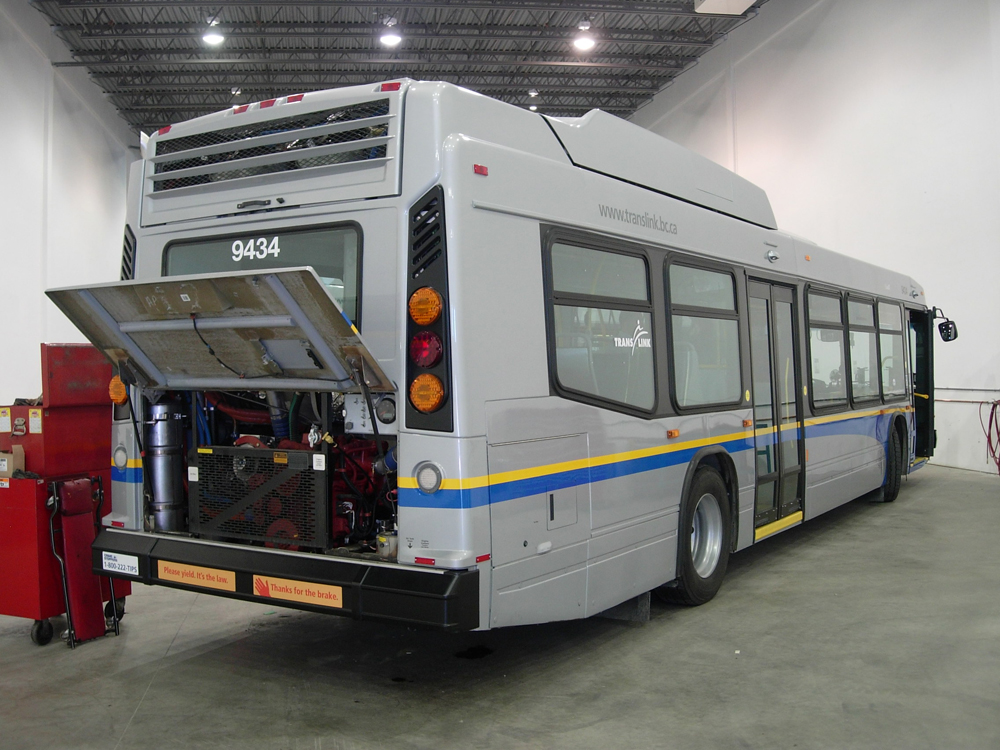
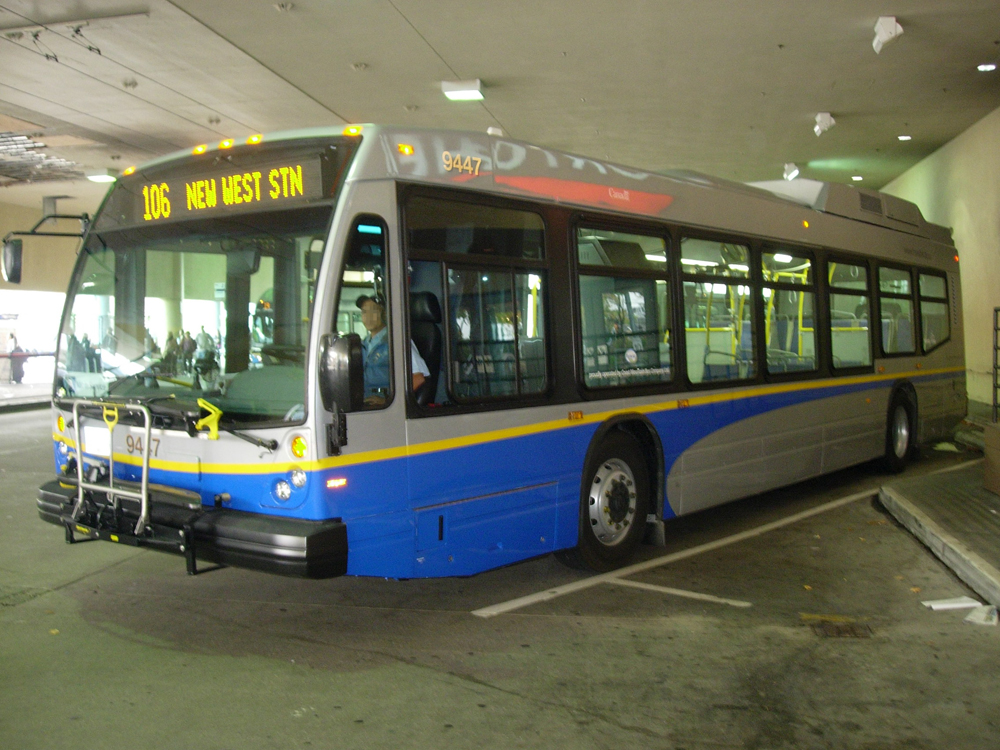
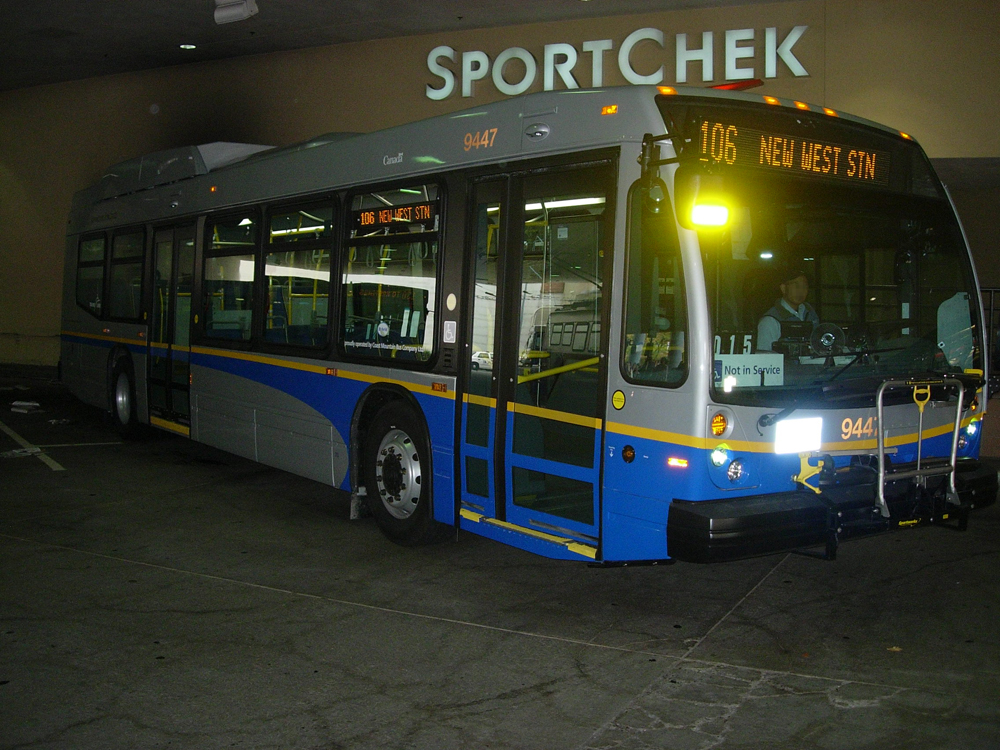
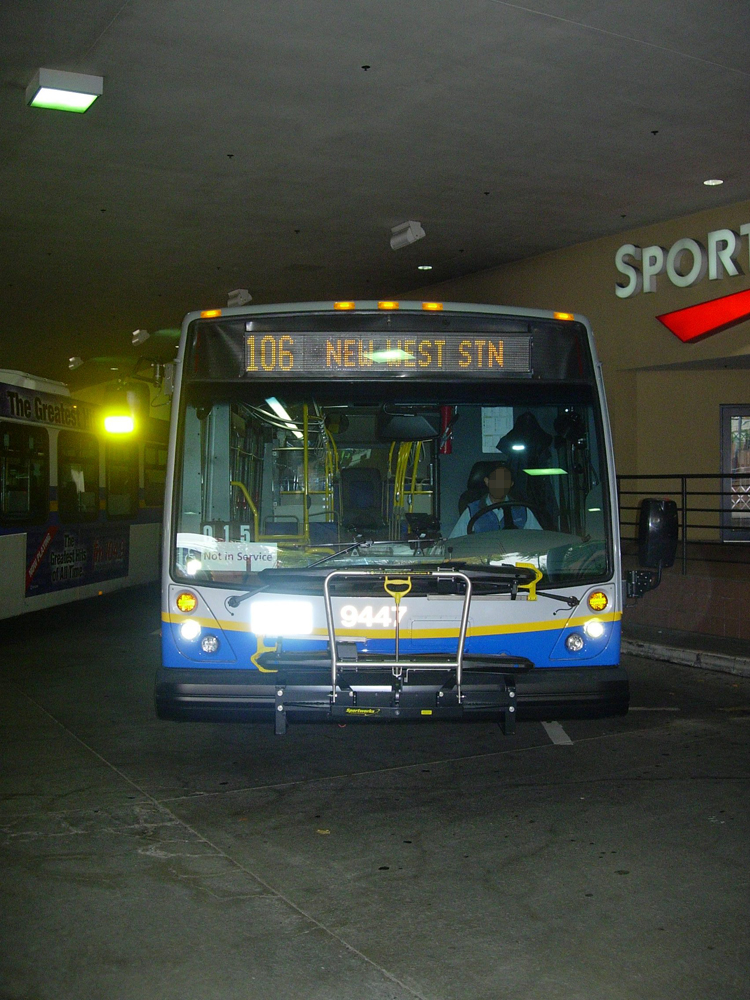
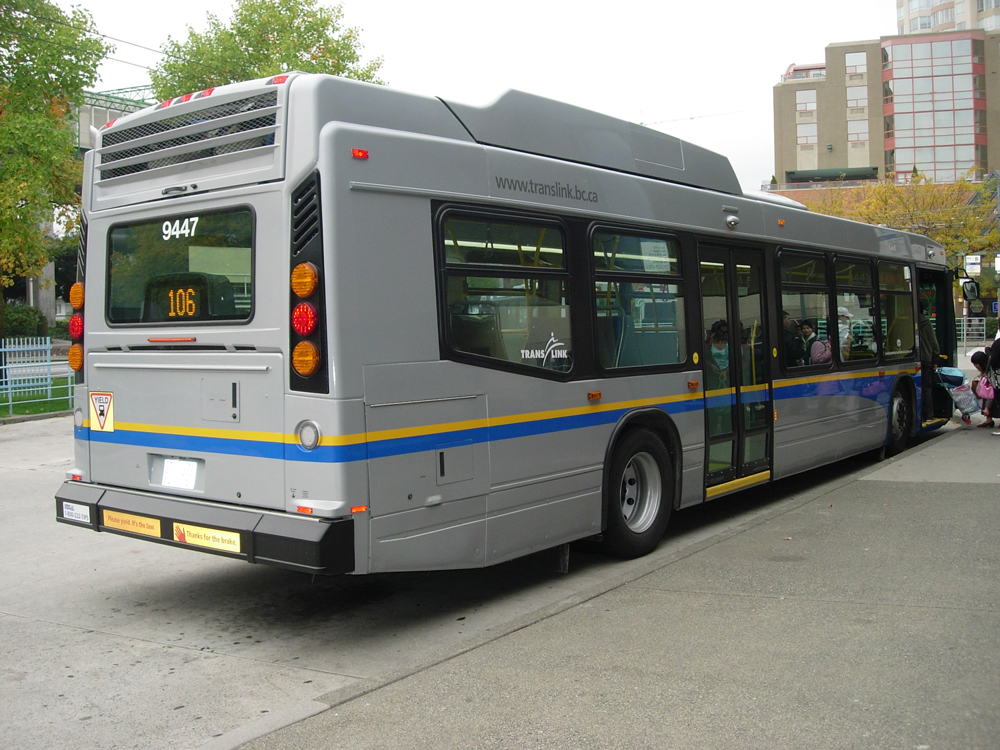
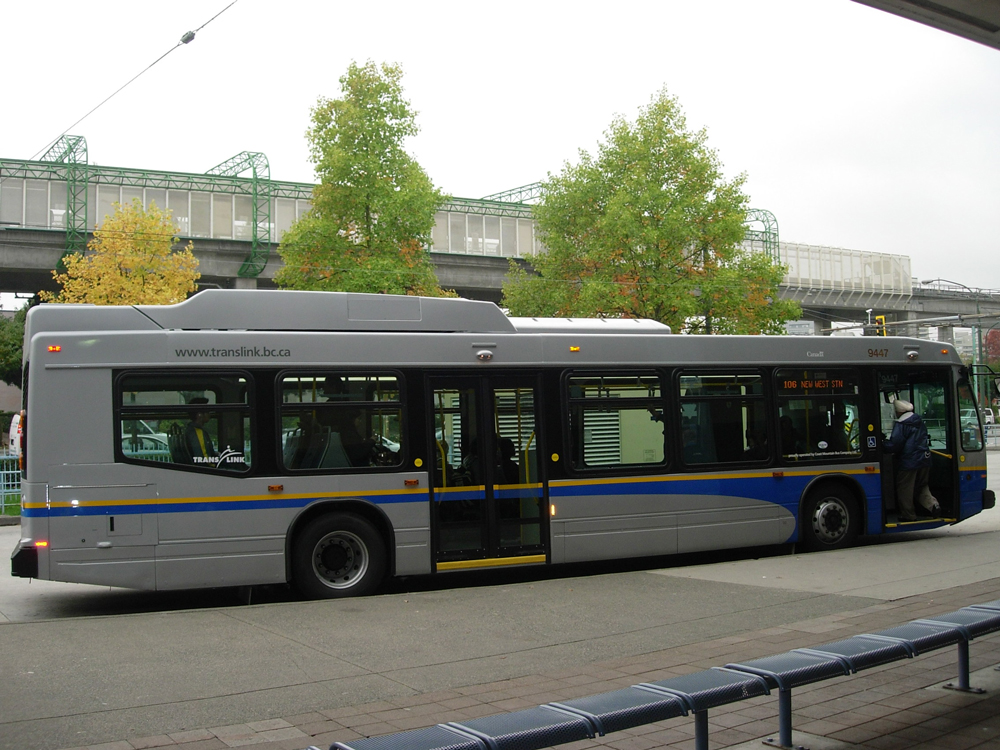
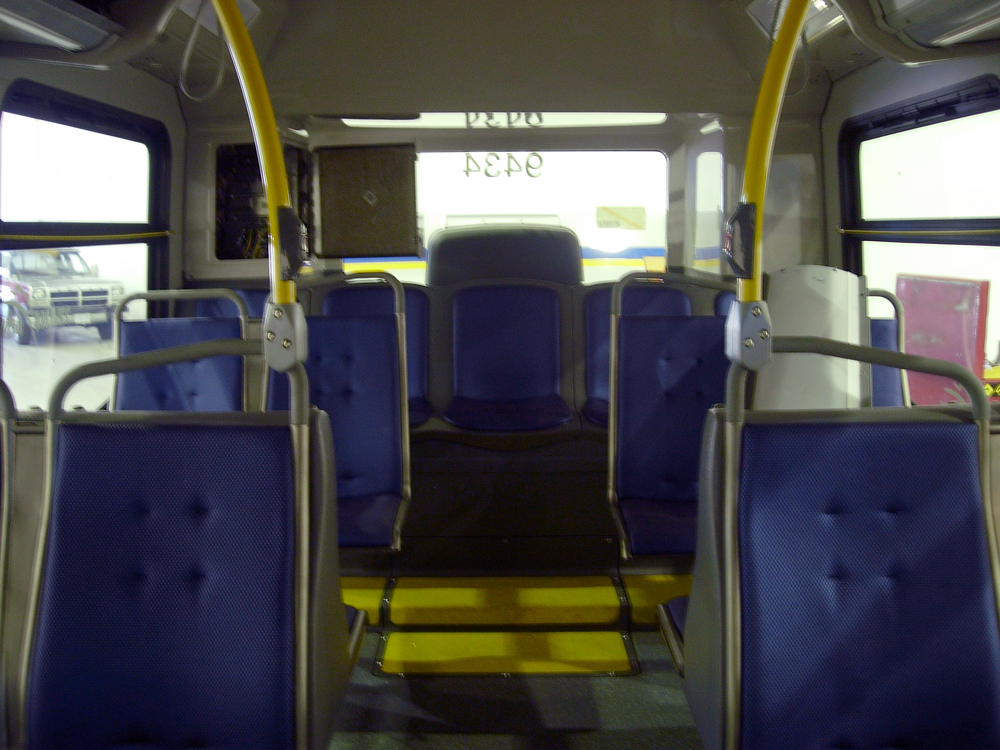






a full bench at the rear? Nova got it right this time! Of course, Burnaby gets all the new stuff. (of course not counting all the trolleys Vancouver got)
Now there in Vancouver
Sure is a nice bus. I wonder if they are quieter than the current Nova’s, not that their noisy to begin with. The layout looks better too. I like the sticker on the rear door.
I personally don’t like the rear facing seats all that much because the average set of 4 people will not be able to fit into the 4 seats unless their legs all intermingle.
Nice! That is a smart-looking bus. Can’t wait to ride one. I like the rear seating layout better than in the regular Novas, as well as the full-sized rear window. Do you know if operators find the hybrids as easy to drive as the diesel Novas? Just wondering.
The only thing I wish they hadn’t done is the arched stanchions. Due to the unpopularity of the ones on the Mark II Skytrain cars, I am surprised Translink decided to go with this design on new buses. It is uncomfortable holding on to them for any length of time (have to hold your back in an unnatural way), and when you’re sitting down, people holding them have to lean into/over you and your face gets bumped with purses, jacket zippers, etc. Oh well. The curved poles do look really cool.
And hey, is that a new style of bike rack on the front?
Verrry nice. I think you should have included information about their fuel consumption. And sometime, Translink and the bus makers should start talking about putting poles on the hybrids, so that you could run with no emissions at all under the wires – but extend the range of routes beyond them. Think of the the #41 to UBC for instance.
That could also work for an electric B-Line (see Gregor Robertson’s newly released “Greenest City” plan).
I had a little ride onboard bus 9442 this morning on rt.26 – I enjoyed the ride while it lasted, the ride quality was very smooth, a little louder than the New Flyer articulated hybrid buses, power was adequate and in general, I was impressed!
Myself and George Prior captured some photos from yesterday and today, and our long-term goal is to capture each and every single one of them, just as we have done for the rest of the 1300 buses in the past! For the meantime, enjoy the photos!
http://www.trans-continental.ca/vancouver/2009novahev
David Lam
Webmaster of Trans-Continental
Agree with Stephen – would love to see some Trolley hybrids that can run off the wire. That way, we can finally start using the 41st trolley wires in regular service, and maybe extend the 9 from Boundary to Willingdon, etc (although trolley wire extensions would be better generally).
Leon: Yeah, personally I agree — I don’t really like the rear-facing seats because your line of sight is aimed directly at other people. I’m told lots of people don’t like the bench seats on the SkyTrain for that reason too.
Stephen Rees: Trolley hybrids! A very cool idea. Btw, which fuel consumption numbers were you after? I do mention in the post that they have 20% better fuel economy than standard, but I can seek out more detail on that if you like.
[…] The Buzzer blog » The Nova hybrid buses are out and about buzzer.translink.ca/index.php/2009/10/the-nova-hybrid-buses-are-out-and-about – view page – cached The first of our diesel-electric hybrid buses from Nova went into service this week! — From the page […]
The Nova hybrids are also the first coaches ordered with LED interior lighting: energy efficient that way too!
Trolley Hybrids are a very neat idea. I was on one in Seattle a long time ago. They used the poles in the downtown tunnel, then once out of the tunnel, drop the poles turn on the engine and away we went on the highway.
Why are ALL of the recently arrived new buses go towards BURNABY (yeah, Burnaby ALWAYS get the new stuff first)??? It seems to me that the Translink execs consider Burnaby to be the centre of the universe and nothing else.
For all of the recently arrived new buses for the past 3 years, ABSOLUTELY NONE (except for a few UPGRADED suburban coches) were given to any of the Richmond routes and Richmond got all of the old buses. Why is that?
I was just curious:
Does the diesel engine power the battery, and wheel are moved by electric engine only, or does the electric engine are assisting the diesel ala “prius”.
I think NeFlyer offer the both technology, but not sure about Nova, and curious to know what is in Trnaslink fleet?
I use the 41 all the time and it really bugged me that the overhead wasn’t being used at least to Dunbar or Crown or wherever it ends. It finally dawned on me that so many buses used 41st to go in and out of service that it wasn’t really possible to put trolleys on the 41. The more trolleys the better I say.
This may all have changed with the Canada Line. Maybe there is an alternate way to get back and forth from the depot now. I haven’t been down to Marine to see what the set up is down there.
I was in Boston last week. The ‘Sliver Line’ from the airport to South Station is an artic. bus (with lots of luggage racks). It leaves the airport as a diesel and part way the driver turns off the engine, gets out, puts up the poles and becomes a trolley for the rest of the route. They must love that when it’s raining buckets or the snow is up the their knees.
Wow! Nice! can we have some of those Nova Hybrids over at the Surrey Transit Centre? Cause it’s kind of boring seeing all these D40LF/LFRs all the time. lol :)
Both New Flyer and NovaBUS offer the Allison Hybridrive, the system used on both the DE60LFR and the LFS HEV.
More information can be found here by clicking on my name.
Nope. Derek Cheung, the hybrid nova buses were not the first buses ordered to have LED interior lighting. The new fleet of community shuttle buses ordered recently already feature LED interior lighting. I think that the LED lighting is too bright and harsh on the eyes. Why didn’t they stick with the classic fluorescent lighting? The light was less harsh on the eyes and provided better lighting than the LED lighting.
I’ve always wondered why the 9 never went to Brentwood Mall. I’m not 100 percent sure, but I believe it’s because Brentwood Mall wasn’t a major transit hub when the trolley wires out to Boundary were laid out.
Ridership is one of the biggest things here. The is within one block of Rupert Station. Anyone wanting to go to Brentwood would simply get off at Rupert and take the much faster SkyTrain. The 28 already serves Henning Way. There’s also the small matter of the SkyTrain between Gilmore and Wilingdon killing a lot of that local ridership this extension needs. But suppose the ridership did exist, as it does on the 41 out to UBC, what then?
Burnaby and Coquitlam are fantastic places to run trolleybuses because of the hilly terrain, but there’s a few problems with running the trolleys out there. The infrastructure needs to be in place. If running wires out to Metrotown cost $3 million (not adjusted to inflation), can you imagine the cost behind installing heavy poles and trolley wires all over? The cost to extend the trolley wires from Blanca Loop to UBC cost $1.5 million (again, not adjusted for inflation). Based on those above costs, extending the trolley infrastructure from Boundary to Willingdon would likely cost $1-2 million. $1-2 million for a bus nobody would ride is rather expensive. And that’s just the infrastructure! The cost of an extension on Marine Drive from Crown to UBC would be astronomical. But if cost wasn’t an issue, then what?
I’m pretty sure Brentwood Mall owns the property the loop sits on, so apart from simply running the wires, Brentwood Mall would need to give the OK if trolley buses are going to be using the loop.
When a bus route needs to cross over into another city, it’s not just a matter of “making it so”. A few things need to happen. When the 116 was extended to the Gelnyon Industrial Area, a motion had to be brought up at a council meeting to approve a lone bus stop on the Vancouver side of Boundary Road. Also, if you remember, when the 99 B-Line went out to Lougheed Mall, care was taken not to route the bus through Coquitlam. I actually don’t know the full reasoning behind this, but at the time it seemed more logical to run it northbound on North Road and have it turn left at Austin Road instead of the u-turn drivers had to make inside the cramped Lougheed Mall loop. That same turn was responsible for quite a few artics shutting down as the driver turned the bus too tight from time to time.
While the 41 out past Crown certainly has the ridership and is run often enough to justify an extension and suppose the logistical and cost issues could be easily taken care of, now what?
Vancouver trolleys have a speed governor of 65 kph. The reason for that is that the wires likely can’t take much beyond that. The poles would likely fly off the wires around 70kph or so. The bridges have a 60 kph limit on them and that’s the only place where the buses may be pushed to the limit. Marine Drive has a speed limit 80kph. That means extending the wires to UBC would result in slower service and traffic conflicts with other drivers as they attempt to drive at or above the 80kph limit.
There’s also the small matter of the residential area west of Crown before the Endowment lands. Huge NIMBYers there. Why else is the speed limit there 50 and not 70 or 80? And they have the money to fight it for a very long time.
Hybrids aren’t worth the trouble. While a timing point could be put at Dunbar or Crown to facilitate the raising and lowering of the poles, that would mean the driver getting out and dealing with that. And suppose for a moment the driver forgot to remove the poles? Driver goes straight accelerating to 60kph for the straightaway coming up and the poles go left because the wires stop at Crown and bam! Not worth the risks and the troubles the drivers would have to put up with.
Trolleybuses will continue to be viewed largely as a Vancouver only option. Metrotown didn’t get trolleys until the SkyTrain was built and UBC didn’t get trolleys until 1988. The policy seems to be maintain the system we already have. To that effect, Vancouver has one of the most modern and best maintained trolleybus systems in the world.
I agree LED light is harsh, but it can be diffused with a cover. Global’s 16×9 did a story awhile back about CFL issue comparison
-mercury
-EMF
-UV
-allergies
-breakage and disposal
Although LED prices have come down, they are still expensive for consumer purposes.
I welcome seeing LED on buses.
I Like the Nova’s as wel. Do they make Articulated buses?
Cliff, the time difference between a local bus from Rupert to Brentwood and the time it takes to get off, walk to SkyTrain, wait for a train and ride to Brentwood is close to zero.
A couple days ago six of us headed from work in Gastown to the Apple store in Pacific Centre. Three took Canada Line from Waterfront to Vancouver City Centre while the other three walked all the way. The Canada Line trio only had a 1 minute wait for a train yet they arrived more than a minute after those who walked all the way.
“Faster” isn’t always faster.
@David2
Oh sure, understandably it *is* a pain to get from Nanaimo to Willingdon. Don’t get me wrong, I empathize. But, even running a community shuttle for the select group of people on Broadway from Nanaimo eastward to Willingdon would not be worthwhile.
@ David
Yep, you might be right, but even taking that into consideration, cost becomes the real issue. Running any sort of bus service between Boundary and Willingdon isn’t going to be worth the ridership it attracts. With a same or better option available, there’s no reason for an extension.
@ Anyone else
I realize my argument against hybrid trolleys isn’t very well thought out. Feel free to pick at it.
Cliff, the original Lougheed Mall terminus of the 99 B-Line didn’t have a proper bay that would fit an articulated coach, hence the actual stop was westbound on Austin.
You can see the abandoned Lougheed Mall bus loop now where they converted three regular 40′ bays into two 60′ bays (the other articulated bay was used for the 145 SFU/Lougheed Mall).
While the trolleys are speed governed to approximately 65km/h, this is not because of the limitations of the trolley overhead. In fact, Kummler & Matter makes trolley overhead capable of such speeds, including switches and crossings.
Vancouver already uses Kummler & Matter hangers on the previously mentioned UBC and Kingsway/Metrotown sections, among others.
Click on my name to see their website.
With H1N1 a concern, can we review which bus doors we physically need to touch to open and which we can magically wave to open?
I found that link about Florescent Light issues. Click on my name link to see it on Global TV.
Jason, you don’t actually have to touch the door to get it to open. About 2-3 centimetres from the picture of the hand is enough. Try it sometime!
:), that story is about CFL’s, not regular fluorescent lights. Would regular fluorescents necessarily have the same issues?
Cliff, now that I think of it, the answer wouuld be to take a 9 *westbound* to Commercial-Broadway and then the M line to BTC. It didn’t occur to me at first as it’s counterintuitive to travel the “wrong way”
The buses that use fluorescent lighting use standard fluorescent lighting. Fluorescent tubes to be exact and not cfls. There have not be issues with fluorescent tube lighting. I wonder why they switched to LED lighting? I would like it if they could switch them back to the classic fluorescent lighting. Adding a cover to LED lighting will diffuse the light but the LED lighting just gives off a horrible light. I prefer the fluorescent lighting, it gives off much better lighting.
I would have thought CFL and regular tubes use the same technology, only smaller.
BTW… on the topic of hybrids, did everyone hear about the gas shortage in Coquitlam and spreading (click on my name link for details)? I wonder if Translink has secured their stash of diesel during this shortage. Otherwise, we may be down to trolleys, Skytrain and Canada Line in the near future.
@Derek Cheung: Yeah, but the 99 turned around in the loop. It would have been far more logical to go straight to North, turn left, then turn left at Austin so it never entered the loop.
Thanks for posting that link. That’s quite a surprise. In that case there’s really nothing stopping a trolley extension besides cost and dealing with the NIMBYs on Marine Drive.
…I would imagine CMBC gets priority during fuel shortages. Think Mad Max before our buses go down :p
There are lots of routes that would be ideal for conversion to trolley. Some of the Burnaby ones could even be run out of the Vancouver Depot because of the connection at Metrotown.
On the main topic… I’m not a big fan of the curved handles. I just don’t feel as comfortable or steady when grasping them.
…nope cfls and regular fluorescent tubes don’t use the same technology. Cfls use less energy to produce more light while regular tubes of the same wattage produce less light. I just hope that translink will switch back to fluorescent lighting. BTW, translink will not run low on fuel. The buses use ultra low sulfur diesel which comes from a totally different source and the have their own pumps at the transit garage.
If diesel and gasoline come from a refineries… and Translink does not refine fuel from crude….. does it not need to compete with the general market? Also if there is a gas shortage, would the refineries just shift their diesel production to gasoline?
I remember reading news a few years ago when gas went to $1.55, Translink was hurting a little financially because they had to pay a premium for that diesel on those buses.
Hi Cliff,
I recall two routings to get to that #99 terminus on Austin: one via Lougheed, Austin, into and through the Lougheed Mall bus loop, and the other via Lougheed, North Road, Austin.
Perhaps it was a change made to address the delays caused by making two left turns at two very busy intersections, especially during the peak hours.
Jason:
Derek Cheung makes a good point about not really having to touch the doors. But besides that, we’ve been advised by public health authorities that the most important defense against H1N1 is washing your hands properly, and that extraordinary measures aren’t needed to control the spread of H1N1 through transit.
Here’s a Georgia Straight article where the B.C. Centre for Disease Control talks about why extraordinary measures aren’t needed on public transit to stop the spread of H1N1.
Also, here’s our press release on the same subject.
@Jason V: There are a few busses where only a wave is needed as Derek described. They are the Nova’s and 60′ Articulated trolleys/hybrids. Pushing on these doors just makes the alarm activate and makes them not open, a safety feature im guessing even if the door is activated. So as far as I know, every other type of bus in the system requires you to touch the bar to open, except the older high floor buses where you just step on the top step to open.
I think we need to bring back “the paddle” like from the 70’s. If the paddle is here today, it would really discourage people from standing in the doorway, as well as people sneaking in the rear doors.
Re: paddle: You mean these (click my name for link to photo)?
Something like that would be a good way to prevent people from standing in the doorways… it could be set to automatically spank people who sneak in the back doors too. :)
Yes, those are the ones.
And slap them silly too!
The “paddle” is known as a McKay gate.
Incidentally, the Nova doors with touchbars can also be opened without actually touching the touchbars.
Merely put your hand between the touchbars and watch the magic happen!
@ Derek C: I must have the unfortunate distinction of never seeing that! I’ll take your word for it though – during rush hours those two left turns can be pretty bad during peak times.(Especially with no traffic light at Government Place at the time [Now Gatineau] and drivers making an unprotected left, thus blocking the left lane the bus would have needed to be in for the turn at Austin).
I remember the Nova pilot bus having that whole hand wave thing and I thought that was pretty neat. It seems like those guys over at Nova Bus do things a little different. New Flyer could learn a few things from their ingenuity.
With swine flu going around, I think it’s a little funny about how we’re concerned about the touch bars when we had an old low tech solution way back (merely stepping down). Of course, it’s a bit of a moot point if the bus has nowhere to sit or is crowded.
I got around to thinking, why not some kind of anti bacterial surface on the grab bars? I googled and came up with a few hits. The most interesting is a news story from Japan. Click my name to view it.
Imagine how innovative TransLink would be to undertake such a project! They could even turn it into a study by doing a control before applying the coatings, then taking another survey after!
Re paddles/McKay gates
What’s the issue with people “sneaking on” via the back doors? I thought the whole system, buses included, went to POP a year or two back. Why do those of us with passes or validated fares still all have to queue up at the front of the bus and waste everyone’s time? If they can have back door boarding at one stop (99 at Broadway Station), why not at all of them?
It would be fantastic to have back door boarding for many of the routes in the system, including those with 40ft buses. The problem with people “sneaking on” is that 9/10 times, those people dont have fares. Also, many of the buses are not set up properly to do it, for example, the skytrain chime you hear on the bline, is not on many of the other buses. Also, there are many stops where all door boarding may not be safe, such as stops with news paper boxes etc. Safety is always #1.
Well isn’t the idea of a POP system that there is someone checking fares (or at least the threat thereof)? And yes it may not be as easy to do on a bus as on a train but it can be done.
Most of the buses in the system don’t have that chime. Neither do buses and streetcars in Toronto, but they’ve had back door boarding at subway stations there for over forty years (55 years if you count the old streetcar platforms on Bloor Street pre-Bloor-Danforth Line). Though I understand what you’re saying about
on-street all-door boarding. It’s still in its infancy in Toronto too. But clearing out the junk around bus stops wouldn’t hurt…
Speaking of the Nova bus project, does anybody know what happened to the P1003 Orion VII hybrid test bus? A rode more than a dozen of these in Toronto, and now have added newer Orion VII next-gen hybrids to the system. These buses as I recall were best hybrids I rode. Other cities like New York, Ottawa, and St Johns have these buses.
It would be nice if Vancouver were to have one these buses even though we’re running into a funding crisis.
Hello hello,
Sorry for the lateness of this: I’ve been sorting out getting answers to your questions over the last little while. Here’s what I know for sure so far… I’ll update with any corrections if need be.
Reva: No, that isn’t a new style of bike rack – it’s the same as all the other Novas. It might look different from the New Flyer racks because those are slanted, owing to visibility issues.
Derek, Ric: These buses do indeed have LED lighting – although I haven’t yet confirmed if the community shuttles got them first. LED was chosen because they last longer and require less maintenance compared to fluorescents. The lights don’t usually fade as they age (in comparison to fluorescents), and even if a few bulbs burn out, the lighting remains relatively the same (there are hundreds of LEDs under the panels). LEDs also consume 1/3 less energy than the previous flourescent interior lights.
Cree, Henry: The reason they are running in the Burnaby area at the moment is because they are a relatively new technology, and since the majority of the CMBC Engineering Department is located at BTC, they wanted to keep a close watch on them while they’re still relatively new. They will probably be moved around, most likely to Vancouver, within a year, since they’re really designed for stop and start service like Vancouver, rather than hilly terrain like in Burnaby. Again, hybrids need slow urban service with lots of stops and starts to be most efficient.
voony: The Nova Bus and New Flyer Artic both run on the Allison Hybrid Drive, as some others have mentioned. The electric motor and the diesel engine run in parallel. The buses typically start off from stop on the electric motor, then transition to blended electric and diesel engine propulsion, and above 70 kmh are entirely diesel engine propulsion. They have regenerative braking to recharge the battery pack when braking, and when idling, the diesel engine charges the battery pack as well.
Gordon: As of summer 2009, Nova does in fact make articulated buses – but they are a relatively new product, and they do not yet produce articulated buses powered by hybrid engines. We stuck with the New Flyer Artic because at the time of the contract, the Novas were either too new, or not proven – plus we already had good previous experiences with the NF artic. I wouldn’t be surprised if we see Nova articulated buses on the streets some day in the future when another order of articulated buses is required – but that of course depends on whoever wins the competitive proposal process. The Nova hybrid artics will likely be available in 2010/2011.
Stephen Rees: about fuel consumption, the 20% better fuel efficiency stat is what we have right now. Testing is being done in Ontario with our buses, however, and more stats on fuel efficiency from those tests will likely be available soon.
zack: about the P1003 Orion test bus — yes, we did indeed test it on our streets. Orion also participated in our competitive RFP process when we were seeking hybrid buses, but the Nova bid beat them out.
Correct me if I am wrong, but didn’t CMBC say that the new Nova hybrids will result in an increase of 25 more buses in Surrey? Based on what you said on the post, it looks like Vancouver, Burnaby, and possibly North Vancouver will get these buses. Surrey has more longer and rural stops, so probably the hybrids wouldn’t be comfortable operating on routes such as the 502. :)
Hmmm, let me ask about that. But you’re definitely right that Surrey routes wouldn’t be ideal for the hybrids, since as mentioned they do need to run on routes with frequent stops and starts to keep the battery charged.
OK, well, so the word is that the hybrids would operate out of Vancouver and Burnaby, and that would allow for reallocation of other buses out to Surrey. However, the press release about this is from a while back, and I am not sure how this plays out now in light of our changed financial standing.
Is there a way to dim the LED interior lights? The light is too bright and harsh to the eyes. Also since the canada line has its own fleet of trains ordered for the line how come they still used fluorescent lights, when newly ordered buses used LEDs? As well how did the buses using fluorescent lights manage to light them? As far as I know fluorescent lights operate on 110 volts AC and not 12 volts DC which is what is used on the diesel buses. Did the buses feature some kind of power inverter to convert the 12 volt DC into 110 volt AC? As well how many volts of electricity do the canada line trains and trolley buses operate on?
You can always wear sunglasses. Oakley has lenses with various strengths.
When I was driving the 22 yesterday (perfect route for the hybrids, lots of stop and go), I noticed a few of them were operating on some North Vancouver runs from Burrard station. How are they on the hills? As for the voltage on the trolley buses, they operate at 600 volts and I think the Canada Line does to, but im not to sure.
Bill Kinkaid: so, about all-door boarding. I don’t think we’re considering all door boarding system wide right now though we have been asked about it. Currently the few routes that have three-door boarding were chosen because their fare evasion rates are likely to be low in the first place, plus the three-boarding method on these routes offers a valuable increase in reliability on the route, which can translate into savings (we can provide more frequent service with the same amount of buses if the loading headway is reduced, ). Obviously not all routes will qualify for all-door boarding under these conditions.
The 99 is a good example — since it’s going to UBC, a large majority taking it are likely to be U-Pass holders. Also, since Commercial Drive Station is the other end of the 99 route, you have lower chances of fare evasion there, since people are often transferring from SkyTrain to the 99 and have their fare already. And the 99 is super busy, so little things like all-door boarding can really boost the service reliability and affect service for a great many people.
Brandon M: It sounds like you work at translink. Are you talking about 600 volts AC or DC?
@Ric Im not sure if its DC or AC, I just know 600 volts.
Trolleys use 600V DC.
Thanks Jhenifer. The points made on all-door boarding are reasonablem, given that fares apparently still need to be checked on boarding.
But I still keep wondering: a couple of years or so ago they made much ballyhoo about the whole system going POP, making buses Fair Paid Zones etc, and just as quickly and quietly dropped it, or at least any mention of it. So are buses FPZ or not? And if they are, why do we continue having to have 50 people filing through the front door of a bus at a time, many of them with passes and validated tickers, when they could be loading in half the time and saving everyone’s time?
Bill: I’ve been wondering this as well. Logically it’s got to be one way or another. I remember reading not so long ago that, as of the “all buses are FPZ” introduction, drivers were specifically no longer enforcing fares — in part because of a number of physical assaults that were being perpetrated.
Of course I mean “one way or the other”. And by perpetrated, I mean against the drivers, by low-life imbeciles.
How many volts of electricity do canada line trains operate on?
Bill & ben: I believe that yes, Fare Paid Zones are in part to protect drivers from assaults. I’ll double check and see what the full answer about the zones is though.
Ric: Canada Line trains use 750V DC.
Guess what! I think we just broke a record for the longest thread in this post. (63 posts)
Yes, we’re certainly getting up there! I’ve just checked though and there seems to be a ways to go before we hit a record. The Canada Line opening announcement post in August has 109 comments, and this Central Valley Greenway tour post has 84 comments. Go go comments go!
Do the Expo and millennium line trains us the same voltage as the canada line trains?
Ric: No, Expo and Millennium use 600V DC like the trolleys.
Why did the canada line trains use 750v instead of 600v?
Perhaps it’s more of a deterrent for those who run across the tracks to catch the trains on the other side.
It’s one reason I prefer center loading platforms, instead of the “twins”.
I think the buses are goodbecause of three reasons:1. They have a full back bench, 2. They have a full back window, 3. THEY ARE GOOD FOR THE ENVIORMENT !!! I saw one when I was going on the Millenium Line once (at Lougheed Town Centre Station.)
But Jhenifer, It looks like a new style of bikerack
Looks like I’m the first to say it. Those buses are absolutely hideous. It looks like the front and back were designed by two completely different people.
The inside looks nice, though :)
Oh CA, I’ll take heart in the fact that you like part of the bus :)
What’s inside is what counts :)
I’m just wondering, I saw one of these new hybrids operating on the 135 SFU route. How do these buses including the DE60LFRs survive the monstrous Burnaby Mountain? I heard in the summer that some of the DE60LFRs broke down while climbing the mountain.
What is the price of a Nova hybrid vs their standard diesel bus? How many years before Translink figures they’ll recover the extra cost?
Lindsay: I sent your question to fleet management and here’s what they told me.
So are we going to have no A/C for all of our buses ever?
Noname: You mean air conditioning right? If I have that right: well, you can never say never. But at the moment it does not seem like a practical expense, given our few days of truly hot weather and the added cost in fuel and maintenance.
[…] […]
Asking questions are actually nice thing if you are not understanding
something completely, however this post offers pleasant understanding yet.
Does anyone know for the diesel and hybrid buses, what’s the battery voltage? is it 24V?